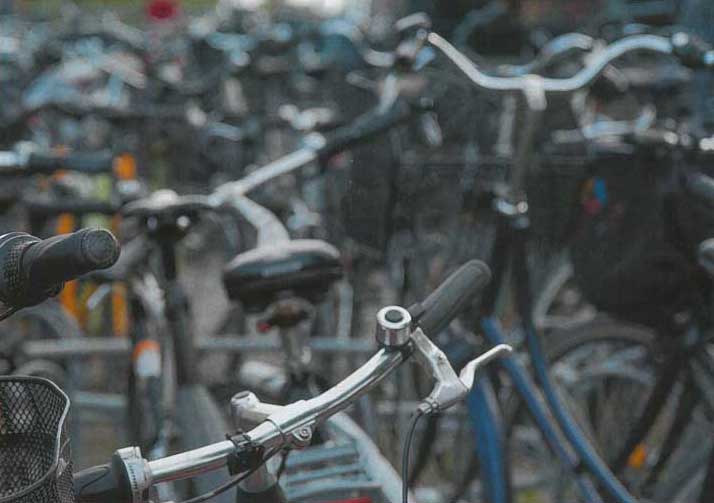Latest News | 10 September 2015
Why the humble bicycle could be at the hub of a city revolution

Could Derby be the perfect Life-Sized City?
This is a question posed following a recent trip to Copenhagen, where I met with Copenhagenize – a company focused on making cities better places to live.
Copenhagenize is headed by Mikael Colville-Anderson, a charismatic and passionate proponent of creating urban environments that work for citizens. And, at the heart of Mikael’s thinking, is the humble bicycle. I’ll come back to cycling later, but first I would like to introduce you to a concept that underpins Mikael’s theory, that of the Life-Sized City.
The global march towards urbanisation continues as millions of people drift towards cities, attracted by opportunities for employment. The United Nations recently reported that, for the first time in our planet’s history, more people now live in urban, as opposed to rural, environments. In Europe, this trend dates back to the industrial revolution whereas elsewhere it’s a more recent phenomenon.
This differential speed of change has led to varied patterns. In the developed world, cities tend to be numerous and, with a few exceptions in a global context at least, be small to medium-sized, generally less than a million or so people.There are exceptions including, in population terms, a few larger cities (London, Tokyo, New York tri-state and the like) and in spatial terms some cities, especially in the United States, that are sprawled across vast areas.
I recently drove across San Antonio in Texas, not a city I had particularly heard of; yet, it was a long 50-mile crawl across town. The developing world is evolving at a much more rapid pace. There, what took 100 years to develop in Europe is taking only 10 years. The result is the emergence of mega-cities: vast and chaotic, unplanned and almost unmanageable crowded cities, where the daily commute can take as much as four hours each way. This is a club that can only be entered once your metro-population exceeds 20 million souls. Membership includes the likes of Lagos (Nigeria), San Paulo (Brazil) and of course many of the cities in China and South-East Asia.
If economic opportunity drives the growth of cities, pretty soon its empowered and educated citizens begin to seek a better quality of life.
Herein lies the space for the Life-Sized City. In many respects, the concept is disarmingly simple – a Life-Sized City is a city that fits human activity. In other words, a city designed around the needs of people, which gets us back to Copenhagen and that humble bicycle.
Let me start with a statistic. In Copenhagen, an astonishing 63% of its working population commutes by bike. The Danish capital’s rush hour is quite a sight – thousands of people quietly moving along from A to B. To British eyes, at first, it’s all quite disconcerting.
Yes, there are the ubiquitous crazy cars and bullying buses, but the dominant vibe is an air of a calm wave motion as cyclists seemingly float across the city. There is no evidence of the middle-aged men in lycra, or the aggressive Le-Tour wannabees, armed with helmet cameras seeking cross-model conflict.
Here, the cyclists wear work clothes, helmets are rare and the bikes look like the one your granny used.There is lane separation on main roads including dedicated cycle traffic lights. And, get this, cyclists follow the road rules – they actually stop on red.
Being British, my colleague and I spent the first half hour tearing around like Mark Cavendish, racing through red and cutting across lanes and pavements. The good folk of Copenhagen looked on us with patient sadness as they waited for us to discover the quickest way about town was the Danish way. We soon joined the quiet waves.
The key to the Copenhagen story is captured in their mantra – ‘it’s not about the bike’. In other words, the bicycle just happens to be the quickest way of getting from A to B, especially in a city for journeys of less than 7 km. In their view the bike is a ‘5th limb’ and nobody will want to cycle for more than 30 minutes.
The move to the bike is not cluttered with ideologies of health or environment. The good folk of Copenhagen are not trying to save themselves or the world, they are just trying to get around efficiently. A few decades ago, the city authorities recognised this and started to design a city that facilitated the shift. Design is the keyword, traffic engineers were seen as the biggest block to progress and they had to throw away their rule book and not try to over-engineer solutions. The result is that it takes £500,000 to create 1km of solution – remarkably little in public transport terms.
Derby is a city that is 5 miles from its centre to edge. The city is large enough to have a critical mass of employment, retail and leisure activity but small enough to escape to its stunning hinterland. Derby doesn’t have endless non-descript suburban sprawl that blights so many UK cities. Derby is a candidate for being the UK’s leading Life-Sized City.
In my experience, all inward investment decisions eventually get to workforce considerations and this invariably leads to quality of life issues. Does the city have the talent and, if not, can it attract talent?
For 10 years, Derby has been focused on regenerating the city centre and to date almost £2billion has been invested. The renaissance of city centres as places to live, work and play has become global.
Derby is now on the brink of a city-living revolution not seen since Georgian times. The idea of living in the centre and commuting out to work – say to Pride Park, the University, Royal Hospital or to Rolls-Royce (that’s 40,000 workers in total) – is becoming a possibility. Currently 3% of Derby’s workforce commutes by bike. The view of the guys at Copenhagenise is that the toughest part is getting to 10%. After that it’s a doddle.
At the heart of the National Cycle Network, Derby has now become recognised as a cycle city. The Arena, triathlons and Bikeworks are all evidence of this. Maybe now is the time to shift beyond leisure and elite cycling into the mainstream and start the next chapter in delivering our Life-Sized credentials.


